Nelson River DC Transmission System
| NR HVDC Transmission Bipole 1 | |
|---|---|
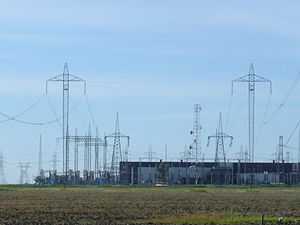 Nelson River Bipoles 1 and 2 terminate at Dorsey Converter Station near Rosser, Manitoba. The station takes HVDC current and converts it to HVAC current for re-distribution to consumers | |
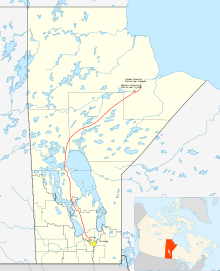 Map of NR HVDC Transmission Bipole 1 | |
| Location | |
| Country | Canada |
| Province | Manitoba |
| From | Radisson Converter Station near Gillam at 56°21′39″N 94°36′47″W / 56.36083°N 94.61306°W |
| To | Dorsey Converter Station at Rosser located 26 kilometres (16 mi) north west of Winnipeg at 49°59′39″N 97°25′38″W / 49.99417°N 97.42722°W) |
| Ownership information | |
| Owner | Manitoba Hydro |
| Operator | Manitoba Hydro |
| Construction information | |
| Manufacturer of substations | English Electric (original); Alstom, Siemens (replacement) |
| Construction started | 1966 |
| Commissioned | June 17, 1972 |
| Technical information | |
| Type | overhead transmission line |
| Type of current | HVDC |
| Total length | 895 km (556 mi) |
| Power rating |
1,620 megawatts 1,800 Amperes |
| AC Voltage | 4,160 V in urban Winnipeg |
| DC Voltage | ±450 kilovolts |
| Number of poles | 2 |
| Number of circuits | 1 |
The Nelson River DC Transmission System, also known as the Manitoba Bipole, is an electric power transmission system of two high voltage, direct current lines in Manitoba, Canada, operated by Manitoba Hydro as part of the Nelson River Hydroelectric Project. It is now recorded on the list of IEEE Milestones[1] in electrical engineering. Several records have been broken by successive phases of the project, including the largest (and last) mercury-arc valves, the highest DC transmission voltage and the first use of water-cooled thyristor valves in HVDC.
The system transfers electric power generated by several hydroelectric power stations along the Nelson River in Northern Manitoba across the wilderness to the populated areas in the south.
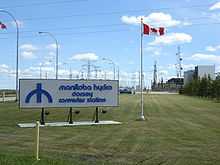
It includes two rectifier stations, Radisson Converter Station near Gillam at 56°21′41″N 94°36′48″W / 56.36139°N 94.61333°W and Henday Converter Station near Sundance at 56°30′14″N 94°08′24″W / 56.50389°N 94.14000°W, one inverter station, Dorsey Converter Station at Rosser located 26 kilometres (16 mi) north west of Winnipeg at 49°59′34″N 97°25′42″W / 49.99278°N 97.42833°W), and two sets of high-voltage direct current transmission lines. Each HVDC transmission line has two parallel overhead conductors to carry the positive and negative feeds.
There are no intermediate switching stations or taps. Both bipolar systems have extensive ground return electrodes to allow use in monopolar mode.
History
Construction in 1966 of the 1,272 MW Kettle Rapids generating station required a long transmission line to connect it to load centers in the southern part of Manitoba. The Government of Canada agreed to finance installation of an HVDC line to be repaid by Manitoba Hydro when the load growth permitted the utility to assume the debt due to the line. Delivery of direct current electric power began on June 17, 1972.
One unit of the Kettle generating station was completed before the direct current converters were completed.[2] For the winter of 1970 the bipole lines were energized with alternating current, contributing a useful amount of energy to the Manitoba system; a shunt reactor was installed to prevent excess voltage rise due to the Ferranti effect.
At that time, Bipole I used the world's highest operating voltage to deliver the largest amount of power from a remote site to a city, and employed the largest mercury arc valves ever developed for such an application. The line required construction of over 3,900 guyed towers and 96 self-supporting towers across varied terrain. Permafrost in some areas led to foundation settling of up to 3 feet (1 m).
The loan by the Government of Canada was discharged when Manitoba Hydro bought the line and outstanding debt in 1992.[3] In 1997 a tornado damaged 19 towers of the DC lines. During repairs, some major customers were advised to curtail load, but imports over the 500 kV lines from adjacent utilities in the United States prevented serious interruption of power.
A third such line, called Bipole 3 has been proposed, with current plans calling for it to run along the west side of Manitoba. On October 26, 2009, the Canadian Taxpayers Federation, along with engineering and environmental experts, released analysis which they claimed refuted each of the government's claims for why the line must be built down the west side of the province.
System components
The transmission system is currently composed of two bipole transmission lines with their converter stations and ground return electrodes to enable monopole operation.
Bipole 1
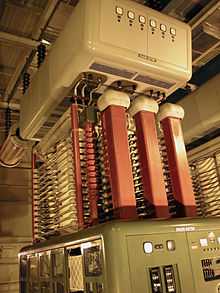
By the end of 2004 all of these mercury valves had been replaced with thyristors.
Bipole 1 runs 895 kilometres (556 mi) from Radisson to Dorsey. It was originally rated to run at a maximum potential difference of ±450 kilovolts and a maximum power of 1620 megawatts.[4] This results in an electric current of 1800 Amperes.
Bipole 1 consists of six, 6-pulse converter groups at each end (three in series per pole), each originally rated at 150 kV DC, 1800 A.[5] Subsequent upgrades have increased the current rating to 2000 A and the voltage rating of most equipment to 166 kV per bridge (i.e., 500 kV total), although as of January 2013 Manitoba Hydro still report that the line is operated at +463 kV/-450 kV.
When it was built between March 1971 and October 1977, mercury-arc valves were used to rectify the alternating current. These valves, supplied by English Electric[6] each had six anode columns in parallel and were the most powerful mercury arc valves ever built. Between 1992 and 1993 the mercury arc valves of Pole 1 were replaced with thyristor valves by GEC Alsthom, increasing the maximum power and voltage of the line to its current levels. The mercury arc valves of Pole 2 were replaced later by Siemens.[7] By the end of 2004 the last of the mercury arc valves in Pole 2 had been replaced by thyristor valves.
Bipole 2
| NR HVDC Transmission Bipole 2 | |
|---|---|
| Location | |
| From | Henday Converter Station near Sundance Bipole 2 at 56°30′15″N 94°08′26″W / 56.50417°N 94.14056°W |
| To | Dorsey Converter Station at Rosser Bipoles 1 and 2 at 49°59′39″N 97°25′49″W / 49.99417°N 97.43028°W |
| Ownership information | |
| Owner | Manitoba Hydro |
| Operator | Manitoba Hydro |
| Construction information | |
| Manufacturer of substations | Siemens, AEG, Brown Boveri |
| Commissioned | 1985 |
| Technical information | |
| Type | overhead transmission line |
| Type of current | HVDC |
| Total length | 937 km (582 mi) |
| Power rating | 1,800 megawatts |
| DC Voltage | ±500 kV |
| Number of poles | 2 |
| Number of circuits | 1 |
The Bipole 2 transmission line runs 937 kilometres (582 mi) from Henday to Dorsey. Bipole 2 can transfer a maximum power of 1800 MW at a potential of ±500 kV. Bipole 2 consists of four 12-pulse converter groups at each end (two in series per pole) and was put into service in two stages. After the first stage in 1978 the maximum power was 900 MW at 250 kV, which increased to its present figure when it was completed in 1985.[8]
Unlike Bipole 1, Bipole 2 has always been equipped with thyristors. The thyristor valves, supplied by the German HVDC consortium (Siemens, AEG and Brown Boveri) used water cooling[9] for the first time in an HVDC project. Until that time, the relatively few HVDC schemes using thyristors had used either air cooling or, as on the Cahora Bassa project supplied by the same consortium, oil-cooling. The thyristor valves were arranged in floor-mounted vertical stacks of four valves each (quadrivalves). Each valve contained 96 thyristor levels in series, with two in parallel. These were arranged in 16 thyristor modules connected in series with 8 reactor modules.
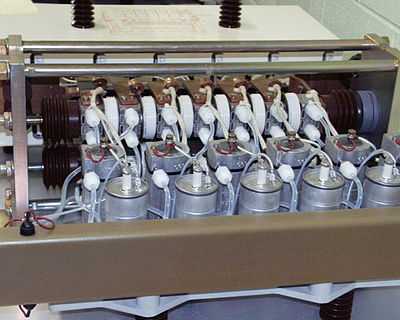 The Bipole 2 thyristor valves: Six parallel-connected pairs of thyristors in a module, with cooling piping and voltage grading capacitors. |
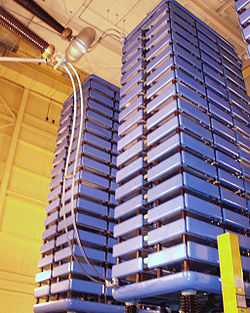 An 1800 A 250 kV quadruple thyristor valve at the Manitoba Hydro Henday converter station in Bipole 2 |
Bipole 3
In 1996 an extreme wind effect damaged both Bipole I and II and threatened to black out Winnipeg. Power was maintained by importing from Minnesota while the two existing Bipoles were repaired. To avoid a repetition of this event, and further improve the reliability of the power supply, Manitoba Hydro is examining routes further to the west for their Bipole 3 line. The plans also include an additional converter station and feeder lines around the city. The in-service date for Bipole 3 is 2017.[10]
Ground return electrodes
Although normally both lines run as bipolar systems, if a pole is shut down for maintenance or a fault, the ground return electrode is used to maintain partial capacity operation.
Bipole 1 and 2 share a ground electrode of ring type, 305 metres (1,001 ft) in diameter, 21.9 kilometres (13.6 mi) from the Dorsey Converter Plant at 50°10′29″N 97°24′08″W / 50.17472°N 97.40222°W. The Dorsey electrode is connected with the converter plant by two overhead lines on wooden poles, one for Bipole 1 and one for Bipole 2.
At Radisson, Bipole 1 uses a ground electrode of the same size and type as Dorsey, but only 11.2 kilometres (7.0 mi) away from the station at 56°21′22″N 94°45′17″W / 56.35611°N 94.75472°W.
Bipole 2 uses a ground electrode 548 metres (1,798 ft) in diameter, and 11.2 kilometres (7.0 mi) from the Henday Converter Station 56°26′2″N 94°13′22″W / 56.43389°N 94.22278°W.
References
- ↑ "Milestones:Nelson River HVDC Transmission System, 1972". IEEE Global History Network. IEEE. Retrieved 4 August 2011.
- ↑ Leonard A. Bateman, An Engineering Career in the Hydroelectric Industry, Engineering Institute of Canada Working Paper 22/2004, July 2004
- ↑ L. A. Bateman, "A History of Electric Power Development in Manitoba", in IEEE Canadian Review, Winter 2005
- ↑ Compendium of HVDC schemes, CIGRÉ Technical Brochure No. 003, 1987, pp63–69.
- ↑ Estey, D.S., Haywood, R.W., Rolland, J.W., Willis, D.B.,Nelson River HVDC System Commissioning and Initial Operating Experience, CIGRÉ session, Paris,1974, paper reference 14-102.
- ↑ Cogle, T.C.J, The Nelson River Project - Manitoba Hydro exploits sub-arctic hydro power resources, Electrical Review, 23 November 1973.
- ↑ Dhaliwal, N., Valiquette, R., Keste, A., Haeusler, M., Kuffel, P., Nelson River Pole 2 mercury-arc valve replacement, Paris, 2004, paper reference B4-203.
- ↑ Compendium of HVDC schemes, CIGRÉ Technical Brochure No. 003, 1987, pp104–109.
- ↑ Beriger, C., Etter, P., Hengsberger, J., Thiele, G., Design of Water Cooled Thyristor Valve Groups for Extension of Manitoba Hydro HVDC System, CIGRÉ session, Paris,1976, paper reference 14-05.
- ↑ "BIPOLE III"
External links
- Manitoba Hydro
- http://web.archive.org/web/20051115122606/www.transmission.bpa.gov/cigresc14/Compendium/NELSON1.htm
- http://web.archive.org/web/20051115122606/www.transmission.bpa.gov/cigresc14/Compendium/NELSON2.htm
- http://web.archive.org/web/20051115122606/www.transmission.bpa.gov/cigresc14/Compendium/Nelson2%20Pictures.pdf
- Siemens HVDC Reference List